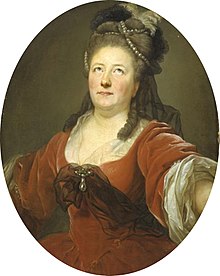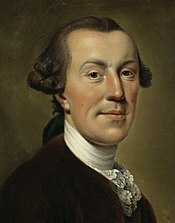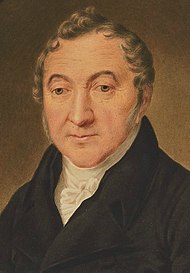Abel Seyler

Abel Seyler (born August 23, 1730 in Liestal , † April 25, 1800 in Rellingen ) was a German theater principal of Swiss origin. He was considered one of the leading European theater principals of the 18th century and the leading sponsor of German theater from the late 1760s to the 1780s. He introduced Shakespeare to a German-speaking audience and promoted the concept of a national theater in the tradition of Ludvig Holberg , the playwright of the Sturm und Drang era and the German-language opera . Before he devoted himself to the theater from 1767, he worked as a controversial merchant and banker in Hamburg .
origin
Abel Seyler grew up in Liestal in the canton of Basel in Switzerland. Both parents belonged to the Basel patriciate. He was the son of Dr. theol. Abel Seyler (1684–1767), who was pastor in Frenkendorf-Munzach in Liestal from 1714 to 1763, and Anna Katharina Burckhardt (1694–1773). He was the grandson of the Reformed theologian Friedrich Seyler and Elisabeth Socin , a member of a noble family from Italy, and was named after his great-grandfather, Abel Socin, the Swiss ambassador to the French court. He also came from the Basel patrician families Merian and Faesch and was a matrilineal descendant of Justina Froben, the daughter of the humanist Johann Froben . He was descended from many of Basel's previous mayors; his distant relatives included Cardinal Joseph Fesch , Napoleon's uncle, as well as the naturalist Maria Sibylla Merian and the orientalist Johann Ludwig Burckhardt . He had a sister, Elisabeth Seyler (1715–1798), who was married to pastor Daniel Merian (1700–1779).
Merchant and banker in Hamburg
As a young man, Seyler settled in Hamburg and worked there as a merchant and banker until 1766. With his business partners Edwin Müller and Johann Martin Tillemann he founded the companies Müller & Seyler and Seyler & Tillemann, which speculated in financial instruments in the 1750s and early 1760s. Among other things, during the Seven Years' War , Seyler and Johann Tillemann traded inferior coins that they had produced in the Rethwisch Mint near Hamburg . The turmoil caused by the deterioration of the coin caused the demise of Seyler and Tillemann's trading house after the end of the war. Müller & Seyler and Seyler & Tillemann went bankrupt in 1763 with more than 3 million marks in Banco , an enormous sum, which attracted a lot of attention. Historian Mary Lindemann described the bankruptcies as deliberate and malicious, and as examples of "fraudulent schemes". Legal disputes related to the bankruptcies were initiated in 1763 and the case reached the Reich Chamber of Commerce .
Seyler as a theater principal

Hamburg Entreprise (1767–1769)
After his companies went bankrupt, Seyler devoted himself to his great passion, the theater. His fascination with the actress Friederike Sophie Hensel (Seyler) , who was considered the most famous German actress of the second half of the 18th century and who later became his second wife, had a major influence on his decision . From 1767 to 1769 he was the main supporter, main shareholder and de facto director of the Hamburg Entreprise - also known as the Hamburg National Theater - the first attempt to build a national theater in Germany based on Ludvig Holberg's ideas . He employed Gotthold Ephraim Lessing as the first dramaturge in the world and attracted important actors such as Konrad Ekhof and Friedrich Ludwig Schröder . The work of the theater was immortalized by Lessing's Hamburg Dramaturgy . The theater was located in the Comedy House and had to close after two years after Seyler had spent the rest of his fortune on it.
Seylersche Drama Society (1769–1779)
In 1769 Seyler founded the Seylersche Drama Society with about 60 members and received from the Hanoverian Elector Georg III. the privilege of being "director of the royal and electoral court actors". The Seylersche Drama Society was considered to be "the best drama company that existed in Germany at that time [1769–1779]". Above all, he was able to win Konrad Ekhof for the troop. In his first year as a principal, however, Seyler did not manage to build on the old successes of the Hamburg National Theater. The lack of public interest in Hanover led to financial problems and when Ekhof became seriously ill in May 1770 and was unable to perform for a long time, the situation worsened dramatically. Seyler's brother-in-law, the court pharmacist JGR Andreae from Hanover, saved Seyler's company from impending ruin by assuming all debts, but demanded that Ekhof take over the management.
In 1771, at the invitation of Duchess Anna Amalia , the Seylersche Gesellschaft went to the Weimar court, where they were warmly welcomed and management passed back to Seyler. At that time Weimar was about to reach its heyday, the Weimar Classic ; Through her patronage, Duchess Anna Amalia attracted a number of the brightest minds of her time to what was later to be dubbed the “ Weimar Court of the Muses ”. After the castle fire in 1774, the troops had to leave Anna Amalia's court and went to Gotha and Leipzig . In 1775 Seyler received the Electoral Saxon privilege and in 1776 he opened a newly built summer theater in Dresden .
In 1777 Seyler renounced the privilege granted by the Electorate of Saxony. For the next two years, the Seylersche troupe was mainly based in Frankfurt and Mainz, with stays in Cologne, Hanau, Mannheim, Heidelberg and Bonn. He is considered the father of theater life in Frankfurt.
Late years (1779–1801)
After 1779 Seyler was involved in the establishment of the National Theater in Mannheim , where he was director from 1779 to 1781. From 1781 to 1783 Seyler was director of the Schleswig court theater. Between 1783 and 1787 he again headed the Comödienhaus in Hamburg, and from 1787 to 1792 he was again director of the Schleswig court theater. In 1792 he retired from Landgrave Karl von Hessen-Kassel with a pension . From 1798 he lived as a guest on the estate of his long-time friend, the actor and prominent Freemason Friedrich Ludwig Schröder in Rellingen, where he died on April 25, 1800 and was buried on May 1, 1800.
Legacy and Assessment
Seyler promoted the concept of a national theater in the tradition of Ludvig Holberg, dramas by the young generation of Sturm und Drang and German-language opera. He employed young dramatists as theater poets and had Klinger's play Sturm und Drang premiered in 1777 , which gave the epoch its name. His work also contributed significantly to making the works of Shakespeare known in Germany. The opera Alceste , which established a German operatic tradition, was written for the Seylersche Gesellschaft by Anton Schweitzer with a libretto by Christoph Martin Wieland and premiered on May 28, 1773 at the Weimar Court Theater.
According to music critic John Warrack:
- The success of Abel Seyler's company in the post-war years was based on his entrepreneurial talent coupled with a talent for attracting talent. He would not have succeeded, however, without the greater respect accorded to the traveling theater troupes in the new climate of interest in drama and, consequently, in dramatic music.
In contrast to other leading theater principals of the 18th century, Seyler himself was not an actor and focused on the artistic and economic direction of the drama society. His middle-class background and past as a merchant and banker were also highly unusual in his new profession. Seyler was an unconventional and colorful personality; he was considered "a man of taste, knowledge, and receptivity to the joys of life". Although he was controversial as a merchant in Hamburg, Seyler was highly valued for his theater work in later life. During his lifetime in 1794, for example, he was called "one of the most deserving men in German art". He was praised by many contemporaries such as Gotthold Ephraim Lessing ; Christoph Martin Wieland described him as a "man of feeling and insight". After his death, his daughter Sophie Leisewitz, the wife of the poet Johann Anton Leisewitz , wrote in the studbook of the actor Friedrich Ludwig Schröder : "I had the happy lot of adoring a man out of filial duty, whom thousands are only allowed to admire."
Freemasonry
Seyler was a Freemason . He joined Freemasonry in London in 1753, became a member of the Absalom Lodge in Hamburg in May 1755 and was involved in Freemasonry until his death.
Abel Seyler and Konrad Ekhof, together with other members of the Seyler's troop, founded the first Masonic lodge in Gotha . The establishment took place on June 25, 1774 in the Gasthof Zum Mohren, on the occasion of the birth of John the Baptist. The lodge was originally called Cosmopolit , but was renamed Zum Rautenkranz shortly afterwards in honor of the ducal family . Its members included several members of the Seyler's troupe, such as the composer Georg Anton Benda ; the ruling Duke Ernst II and his brother Prince August became members shortly afterwards, as well as many nobles and members of Gotha's local elite. Many of the members also became members of the Illuminati Order .
family

|

|
|
|
His brother-in-law JGR Andreae
|
His son LE Seyler
|
He was married to Sophie Elisabeth Andreae (1730–1764) in his first marriage since 1754; she was the daughter of the wealthy Hanover court pharmacist Leopold Andreae and sister of the famous natural scientist JGR Andreae . They had three children: the court pharmacist in Celle Abel Seyler (1756–1805), the Hamburg banker Ludwig Erdwin Seyler (1758–1836), partner in the company Joh. Berenberg, Gossler & Co. , and Sophie Seyler (1762–1833), who was married to the Sturm und Drang poet Johann Anton Leisewitz from 1781 . After the death of their mother in 1764, the children grew up with their uncle JGR Andreae in Hanover. Abel Seyler has had little contact with his children since then.
Seyler married the actress Friederike Sophie Seyler (Hensel) († 1789) for the second time in 1772 . The marriage was childless.
See also
grades
- ↑ The year of his death is incorrectly stated as 1801 in some 20th century sources.
Individual evidence
- ^ Wilhelm Kosch, Seyler, Abel , in Dictionary of German Biography (eds.): Walther Killy and Rudolf Vierhaus , Vol. 9, p. 308, Walter de Gruyter, 2005, ISBN 3-11-096629-8 .
- ↑ Konrad Kratzsch, Klatschnest Weimar: Serious and cheerful, human-all-too-human from the everyday life of the classics. P. 48, Königshausen & Neumann, 2009, ISBN 978-382604129-7 .
- ^ Mary Lindemann, "The Anxious Merchant, the Bold Speculator, and the Malicious Bankrupt: Doing Business in Eighteenth-Century Hamburg," in Margaret C. Jacob and Catherine Secretan (eds.): The Self-Perception of Early Modern Capitalists , Palgrave Macmillan, 2009.
- ^ "Duchess Anna Amalie von Weimar and her theater," in Robert Keil (ed.): Goethe's diary from the years 1776–1782 , Veit, 1875, p. 69.
- ^ Albert Richard Mohr (1967). "Abel Seyler and his services to Frankfurt theater life". In: Frankfurter Theater from Wandertruppe to Komödienhaus: a contribution to the history of theater in the 18th century. Frankfurt am Main: Kramer, pp. 66–81.
- ↑ Communications of the Society for Kiel City History , Vol. 33–34, p. 78.
- ↑ a b Andrea Heinz: Seyler, Abel. In: New German Biography (NDB). Volume 24, Duncker & Humblot, Berlin 2010, ISBN 978-3-428-11205-0 , p. 300 ( digitized version ).
- ^ John Warrack, German Opera: From the Beginnings to Wagner. P. 93, Cambridge University Press, 2001, ISBN 0-521-23532-4 .
- ^ Theodor Wilhelm Danzel, Gotthold Ephraim Lessing: his life and his works , Vol. 2, No. 1, pp. 114–115.
- ^ Heinrich Aug. Ottok. Reichard (ed.): Theater calendar for the year 1794 . P. 241.
- ↑ Der Teutsche Merkur , 1773, I, p. 269.
literature
- Paul Schlenther : Seyler, Abel . In: Allgemeine Deutsche Biographie (ADB). Volume 34, Duncker & Humblot, Leipzig 1892, pp. 778-782.
- Andrea Heinz: Seyler, Abel. In: New German Biography (NDB). Volume 24, Duncker & Humblot, Berlin 2010, ISBN 978-3-428-11205-0 , p. 300 ( digitized version ).
- Thomas Bauman: Music and Drama in Germany: A Traveling Company and Its Repertory, 1767–1781. Dissertation on the Seylersche Acting Society, University of California, Berkeley, 1977.
- Thomas Bauman, "New directions: the Seyler company" (pp. 91-131), in North German Opera in the Age of Goethe , Cambridge University Press, 1985.
- Magazine for the history of the German theater , 1773, VI, pp. 264–276.
- Rudolf Schlösser: From the Hamburg National Theater to the Gothaer Hofbühne . Nendeln / Liechtenstein: Kraus, 1978 [Hamburg, 1895]
- Seyler, Abel in the Carl Maria von Weber Complete Edition
- Adrian Kuhl: "Abel Seyler." In Silke Leopold (Ed.): Lexikon Oper , JB Metzler, 2017, ISBN 978-3-476-02394-0 .
Web links
- Literature by and about Abel Seyler in the catalog of the German National Library
| personal data | |
|---|---|
| SURNAME | Seyler, Abel |
| BRIEF DESCRIPTION | German theater director |
| DATE OF BIRTH | 23 August 1730 |
| PLACE OF BIRTH | Liestal |
| DATE OF DEATH | April 25, 1800 or April 25, 1801 |
| Place of death | Rellingen |
